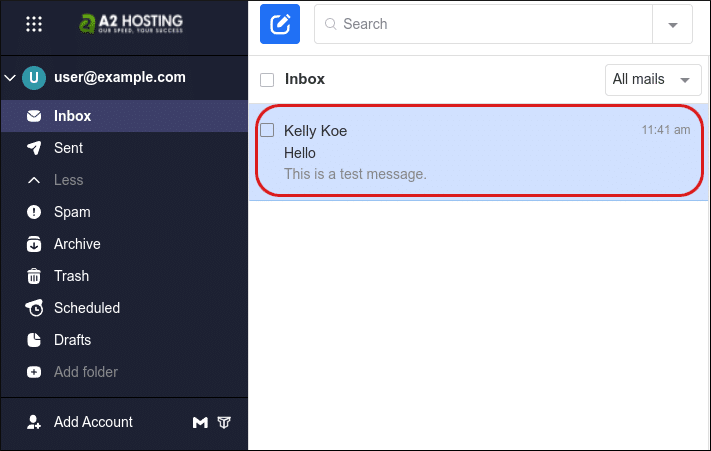A business email address is an email address on your domain, like [email protected]. It provides instant legitimacy and recognition for your brand vs using a generic domain (e.g., [email protected]). Best of all, making a business email address to use for work is affordable and easy: Get a domain, choose a hosting provider, and set up your business email address.
Gmail is our top pick for business email. Starting at $6 a month, build brand credibility with a custom email on your domain with all the communication and collaboration tools your business needs.
Why You Should Use a Branded Business Email Address
Branded email addresses are essential for building a strong brand presence. Here are some of the main ways they benefit your business and you as a professional:
- Appears professional: For you and your company to be taken seriously, you need to have coherent branding, which includes email.
- Increases brand awareness: If the domain you use for email and your website includes your business name, it enhances your brand’s visibility and recall.
- Builds trust: A branded email address conveys integrity and reliability, whereas a generic one may cause prospects to question whether your business will be around for the long haul.
1. Get a Domain
Registering a domain is a straightforward process, but you do have some decisions to make. For example, if you plan to use Google software (e.g., Gmail, Docs, Sheets, and Google Meet), you can simply purchase a domain when setting up your Google Workspace account.
Alternatively, you can get a free domain with a Bluehost or IONOS hosting plan. This option also allows you to skip the next step, as these providers include business email hosting in their plans.
If you need more help, get step-by-step instructions on how to register a business domain name.
Email addresses require a domain to work. The domain is the part of the email address that follows the @ sign in your email address (e.g., yourbusiness.com). Ideally, your domain will be your business name. But if that isn’t available, get more ideas for how to choose a domain name.
2. Choose a Hosting Provider
The next step is to navigate to the email or web hosting provider of your choice and create an account by following the registration prompts. Here’s an overview of some of the top options for professional email hosting:
Top Business Email Options at a Glance
*Billed annually
Not quite sure which to choose? Learn more about email hosting providers and which might be best for your business in our comparison of the best business email providers.
Money-saving tip: If you also need a website, you can get a free domain and email with some web hosting providers. Learn more about how to get a free business email.
3. Decide on a Format & Create Your Email Address
After selecting a custom domain and creating an account, the next step is to create a custom email address by adding a username. There are several different types of formats for business emails, depending on whether they will be used by an individual or shared by a team (like a sales or customer support department).
Need more guidance? Get all the information you need to choose a professional email address. Once you’ve decided on a format for your work email, follow the steps based on which provider you chose. In most cases, it will be as simple as clicking a menu option to create an email address, inputting your username, and clicking a button to make it.
Here are the steps for making an email account on Google Workspace (and Gmail), Microsoft 365 (and Outlook), and Bluehost webmail.
Gmail and Outlook are the two most popular business email apps worldwide. If you want to know which is best for your business, read our Gmail vs Outlook comparison.
Next Steps After Making a Business Email Address
Creating an email address that reflects your brand and business opens up many ways to get more value and maximize the benefits of having a professional email to use for work. Here are some things to do next:
If you’re starting to think there are countless ways to use your new email address to connect with prospects and customers—you’re right. Check out business email examples to find more ways to leverage your own.
Frequently Asked Questions (FAQs)
A good email address for a business will include the company’s name, be on a top-level domain (e.g., .com), and be easy to remember and spell. It’s also best to avoid using extra characters like hyphens, as they make your exact URL harder to recall.
Gmail does have a free version where you can create an email address for personal use. As the email extension is a personal one (@gmail.com), it’s not recommended for business use. If you own a domain name, you can use it on Gmail for business through a Google Workspace account for as little as $6 per month.
It’s possible to create a free business email account on a custom domain. We outline six different ways to get free business email, from providers you may need (or even already be using) for your website to free services you can start with. Keep in mind, though, that you may still have to purchase a domain separately.
Bottom Line
Branded email addresses are a business necessity. Luckily, they are neither difficult nor expensive to get, thanks to the prevalence of cheap email hosting providers on the market. Making one is as simple as getting a domain, provider, and creating an email address to use for work.
https://fitsmallbusiness.com/business-email/




![Top 6 Server Management Software and Tools Compared [2023]](https://ta-relay-public-files-prod.s3.us-east-2.amazonaws.com/icp/product_images/23db1d70048ad120d46c9ea0e43f22e5.png)

